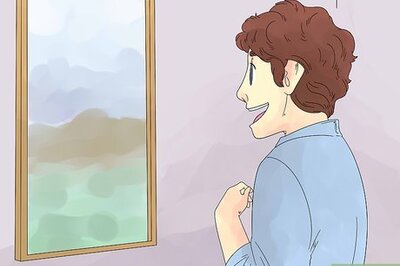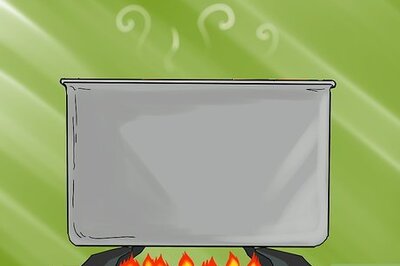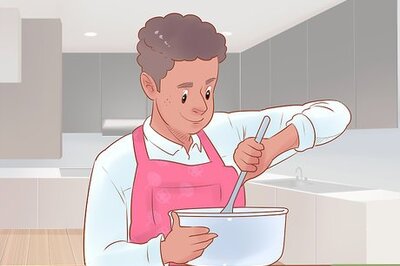
views
Signs a Cantaloupe Has Gone Bad
Mold If you see green, blue, or white fuzzy mold growing on the cantaloupe skin, webbing, or cut-up fruit, throw it out! Mold is toxic and can make you very sick if you ingest it. Some people experience allergic reactions, respiratory problems, and an upset stomach after eating it.
Sunken areas Look at your cantaloupe closely. Are there any areas that look sunken in? If so, those are signs of overripening, rotting, and possibly bacterial contamination, and it's best not to eat the fruit at that point.
Bruising A healthy cantaloupe is golden or sandy-colored. But a cantaloupe that's going bad may start to show dark brown bruises on the skin. These spots are usually soft and mushy when you press on them. They're also a sign to stay away and avoid eating them!
Fermented smell A cantaloupe has a blossom end that sticks out slightly from the skin, like an outie belly button. When you smell it, it should smell fresh and fragrant. If it smells fermented or vinegary, that's your clue that the fruit has begun to rot. Throw it away or, if you're shopping, put it back on the shelf.
Slimy flesh Slime is something you never want to encounter in your fruit, and cantaloupe is no exception. If your cut cantaloupe feels slimy to the touch, or you detect slime on the outside of your whole cantaloupe, don't even bother trying to eat it. Just toss it.
Flavorless, bland taste If you cut into a cantaloupe, eat it, and don't taste anything, you've got a bad melon. However, if it's not showing signs of rotting or molding, you might still be able to eat it. Some people recommend putting salt, fresh lemon or lime juice, tajin, or mint on it to give it some flavor and make it more palatable.
How to Tell If a Cantaloupe Is Ripe
Look for a yellow skin. The skin on a ripe cantaloupe should be golden, sandy-colored, or some other shade of light yellow in between the white webbing. If it's green, the melon isn't ripe yet. If it has dark brown bruising, that's a sign that the cantaloupe is either damaged from poor handling or beginning to rot. In either case, it's a good idea to pass on it.
Pick up the cantaloupe and feel if it's heavy. A heavy cantaloupe is ripe with juice, seeds, and flesh. A lightweight melon isn't ripe yet, so it won't be as sweet or as soft to eat.
Press your thumb against the stem end. The stem end of the cantaloupe sinks slightly into the skin, like an innie belly button. If it's firm with just a little bit of give, then the melon is ripe and ready to eat. If it's hard as a rock, it's not ripe enough, and if it's soft and mushy, it's likely overripe or even rotting.
Thump the cantaloupe and listen for a deep, heavy sound. Flick your thumb or finger onto the surface of the melon while holding it close to your ear. If you hear a deep and heavy sound, the fruit is probably ripe. If the sound that reaches your ear is hollow, it's not ripe yet.
Smell the blossom end. Hold the blossom end (the outie) close to your nose and give it a good sniff. If it smells light, fragrant, and sweet, then you've most likely got a ripe cantaloupe in your hands. If you don't smell anything at all, it's underripe. Finally, if it smells fermented, almost like alcohol, it's overripe and may even be rotting inside.
Frequently Asked Questions (FAQs)
How do you store cantaloupe? Store whole or cut-up ripe cantaloupes in the refrigerator. Store unripe cantaloupes at room temperature until they ripen. Here's a more detailed guide to how long you can store cantaloupe: Whole unripe cantaloupe: Personal chef Markeicha Dulaney says it's okay to leave an unripe cantaloupe on the counter at room temperature for a couple of days until it ripens. Whole ripe cantaloupe: After your melon turns ripe, put it in the fridge to keep it safe to eat for up to 15 days. Cut ripe cantaloupe: Cut-up cantaloupe stays safe to eat for up to 5 days when stored in the fridge.
How long does it take for cantaloupe to go bad? Whole, ripe cantaloupes stay fresh for up to 15 days when stored in the fridge. Cut-up cantaloupe goes bad quicker, so chuck the pieces in the fridge as soon as they're cut and try to eat them within 5 days.
What happens if you eat spoiled cantaloupe? If you eat a cantaloupe that's spoiled or gone bad, you might get food poisoning from overgrown bacteria or mold. Symptoms of food poisoning can include diarrhea, vomiting, fever, and abdominal cramps.




















Comments
0 comment